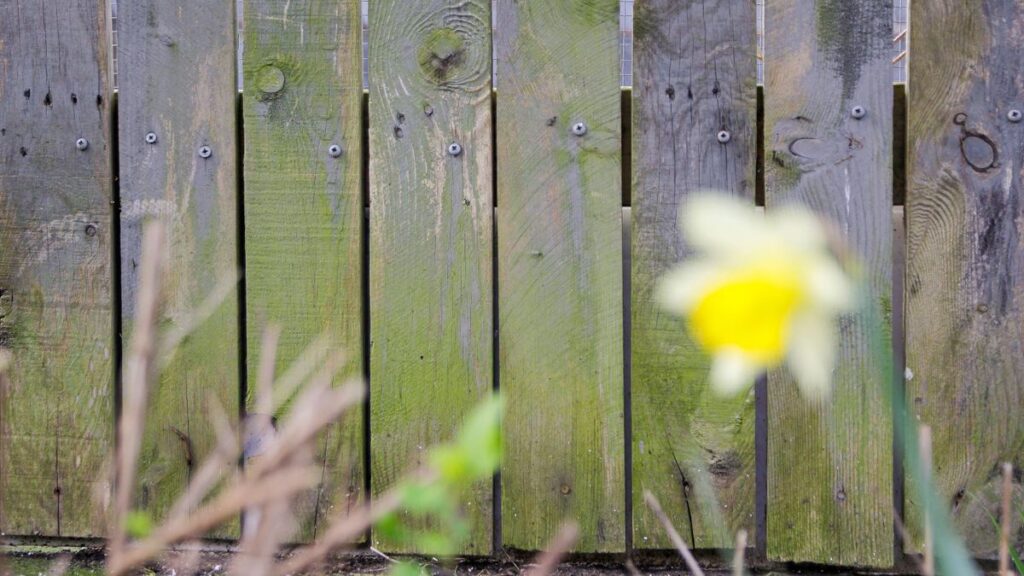If you’ve been busy googling ‘how to remove algae from a fence’ of late, you’re not alone; it’s been a very damp (and dark) winter, which means it’s been near-perfect conditions for algae to thrive.
Algae isn’t just an eyesore on a fence; it can also cause wood rot. Trust us when we say that cleaning the green of a fence is a lot cheaper than replacing one.
‘Fence panels that are prone to algae can be cleaned in a few different ways depending on how big the fence is and what you have available,’ says Morris Hankinson, director of Hopes Grove Nurseries.
‘With a little elbow grease fences can be cleared of algae and look brand new again,’ he adds
1. Use a pressure washer
Whether you’ve spent time researching the best pressure washer or not, you’ll be pleased to know that using one is an easy way to clean algae off a fence.
‘Using a pressure washer is one way to blast off algae,’ says Morris.
‘The pressure of the water will soon lift algae away and you will probably need to clean up afterwards as things can get a bit messy, but it is the quickest and easiest way.’
Morris adds that pressure washers aren’t too expensive or you can hire one for the occasion, but that they ‘do use a lot of water, so keep that in mind when deciding how to get rid of the algae.’
It’s just as important to use the correct nozzle and setting, too, unless you want your fence to disappear in a shower of splinters! Use a low (or medium, if you’re feeling brave) pressure and a wide spray pattern to avoid causing any damage.
2. Get brushing
If you’re wondering how to clean algae from fences and build up a sweat in the process (hey, every little helps when it comes to exercise!), then the Royal Horticultural Society advises you get brushing “to remove established growths”.
‘Brushing [by hand] on a regular basis helps to prevent growths from taking hold,’ explain RHS experts.
You can try using something like the Charles Bentley Stiff Bassine Wooden Hand Scrub Brush from Amazon if you want to try this method.
3. Try a white vinegar solution
If you want to up the ante of your brush, but don’t want to cause any harm to your wildlife garden, then you’re in luck: you don’t need to use harsh chemicals to clean algae from a fence, as cleaning with white vinegar should do the trick nicely.
‘A mix of white vinegar, washing up liquid and water will do a good job at removing algae if you also have a scrubbing brush and some time to dig in,’ says Morris.
‘Safe for you and the garden, this is a good and cheap option to spruce up fence panels.’
4. Buy a purpose-made cleaning mix
First, a caveat: it is best to steer clear of chemical methods when cleaning algae from a fence or hard surface. If you don’t change the growing conditions of the algae it’s likely to just come back.
That being said, there are a few options available if you’d like to buy something that gets the job done – whether that’s a soft, non-destructive wood cleaner like Roxil 200 Wood & Patio Cleaner 5L (200 Concentrate) from Amazon, or even a patio cleaning mix.
‘Patio cleaning mixes, which can be bought at a gardening or DIY shop, can also remove algae from fence panels,’ says Morris.
‘Usually you will apply it, leave for the time advised and scrub or hose off. Be sure to read the instructions and check it is safe to use around pets, children and wildlife – plus, of course, your plants if there are any nearby.’
What is the best algae remover for fences?
If you’re looking for the best algae remover for fences, you might be surprised to learn that the experts advise keeping things natural: a mix of equal parts white vinegar and water should do the trick nicely, especially when paired with a vigorous brushing down.
The RHS also advises you take some time to deter algae from coming back, noting that damp, shady conditions are what cause it to thrive in the first place.
‘Prune overhanging plants to reduce shading and improve air flow; this allows the drying effects of sun and wind to reach the area,’ they suggest.
What causes algae on a fence?
If you’re wondering what causes algae on a fence, the answer is simple enough: damp and shady conditions – which is why it tends to crop up after a miserable winter.
‘Algae grows on wet surfaces and fences are the perfect place,’ says Morris Hankinson of Hopes Grove Nurseries.
‘Wood that stays damp for long periods, such as if it is in shade, will inevitably get some algae growth.’
Once you have learned how to clean algae off a fence, you must take steps to ensure it doesn’t make a speedy comeback.
‘Once you’ve removed all algae, be sure to sand the fence and stain or paint it,’ says Morris. ‘This can help to ensure algae doesn’t take over again.’
Happy scrubbing…
Read the full article here

